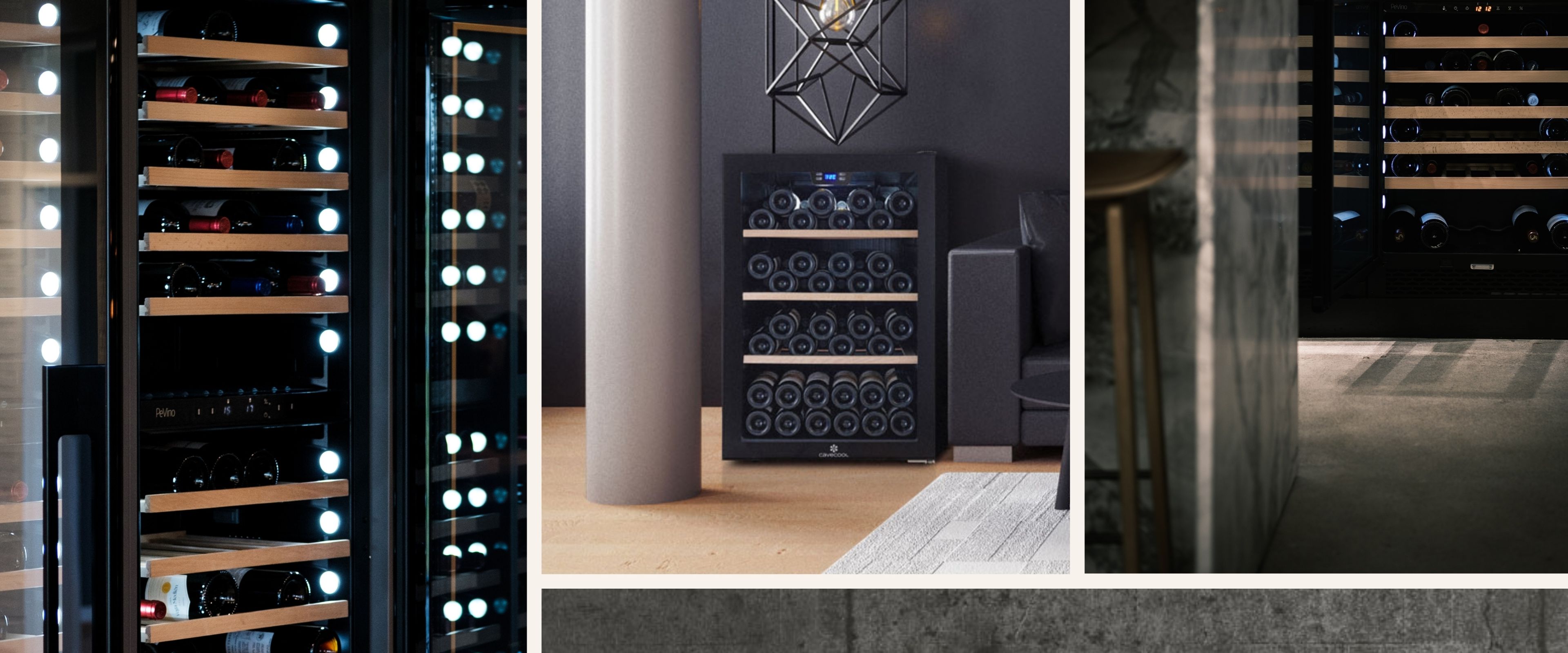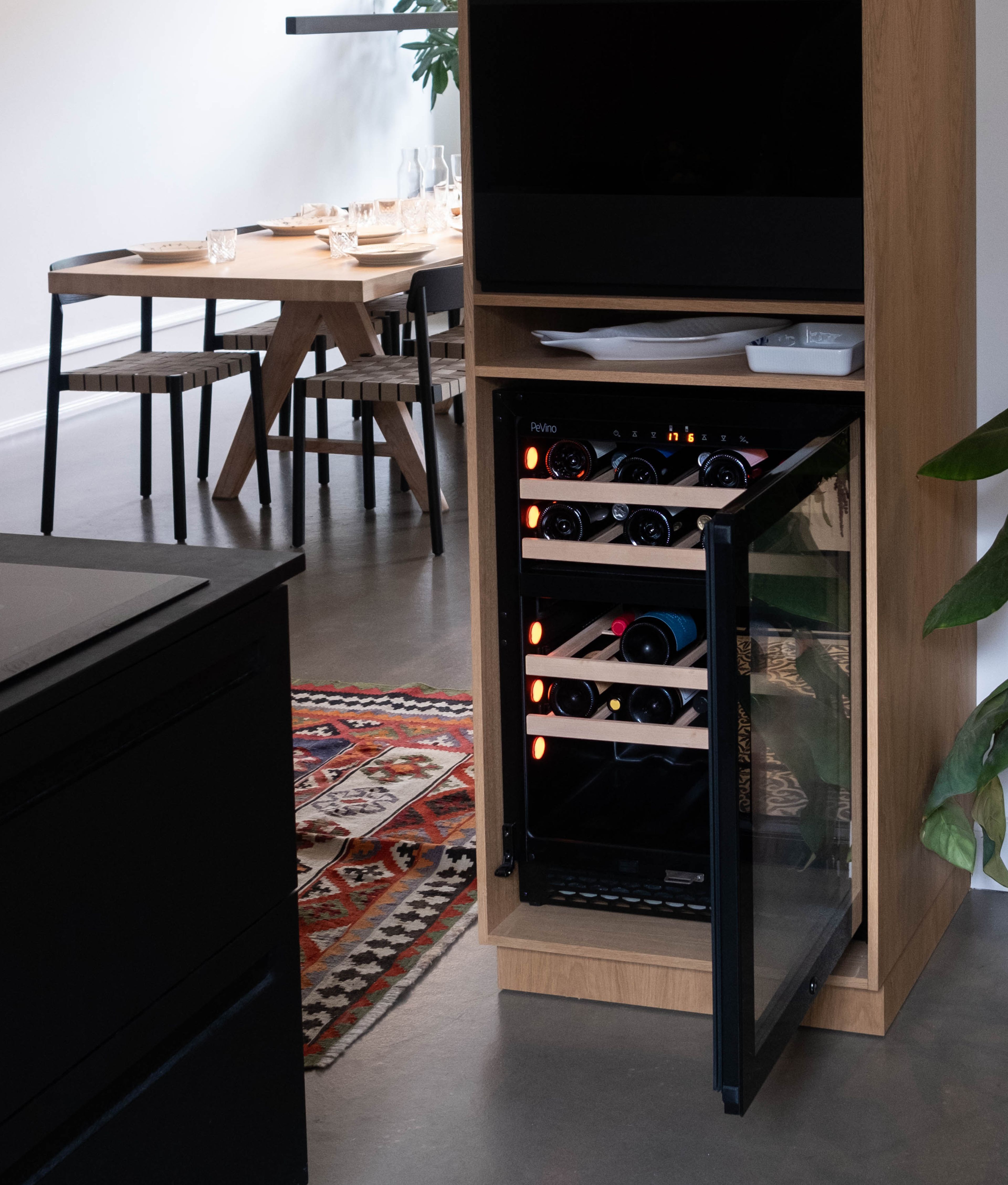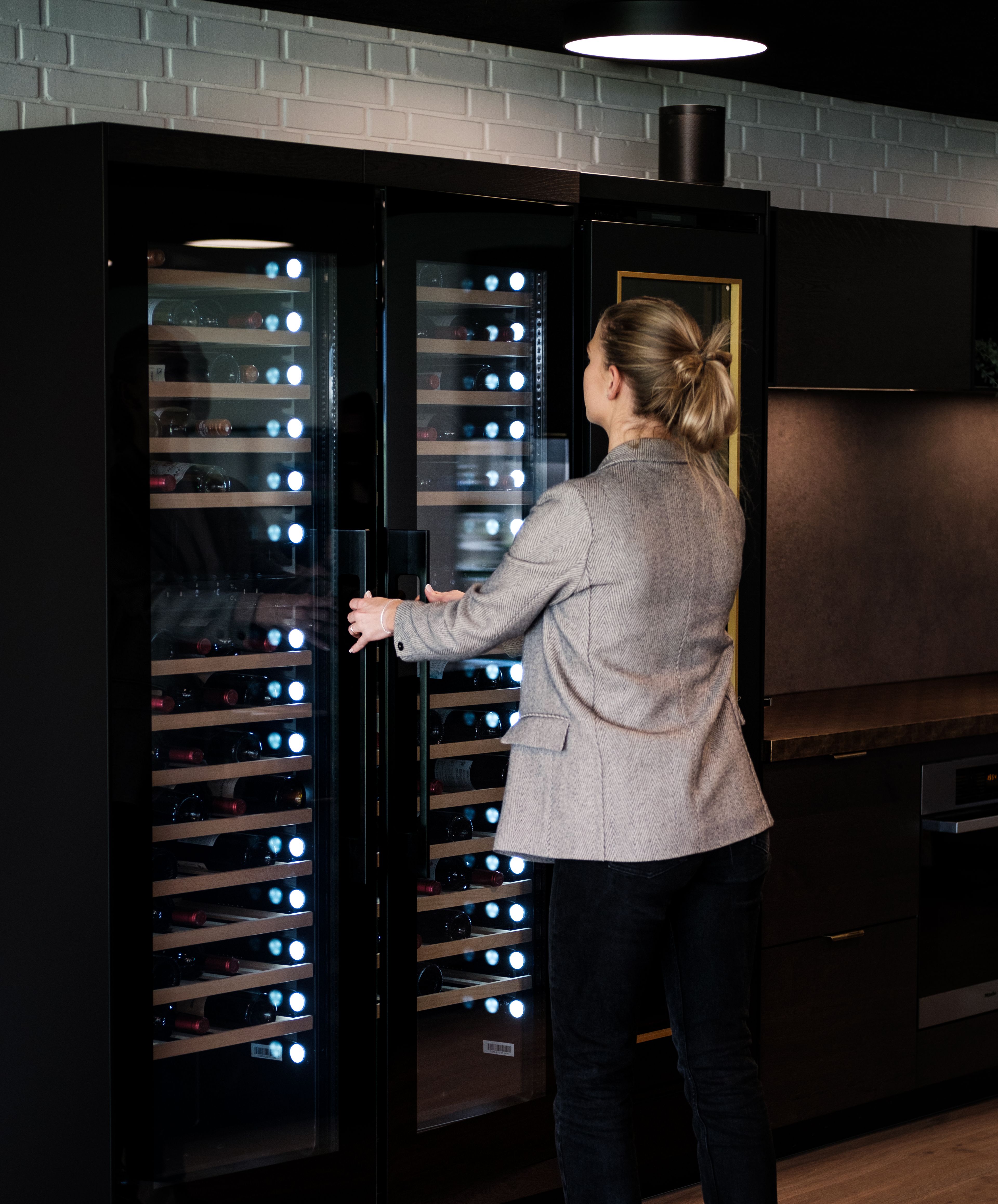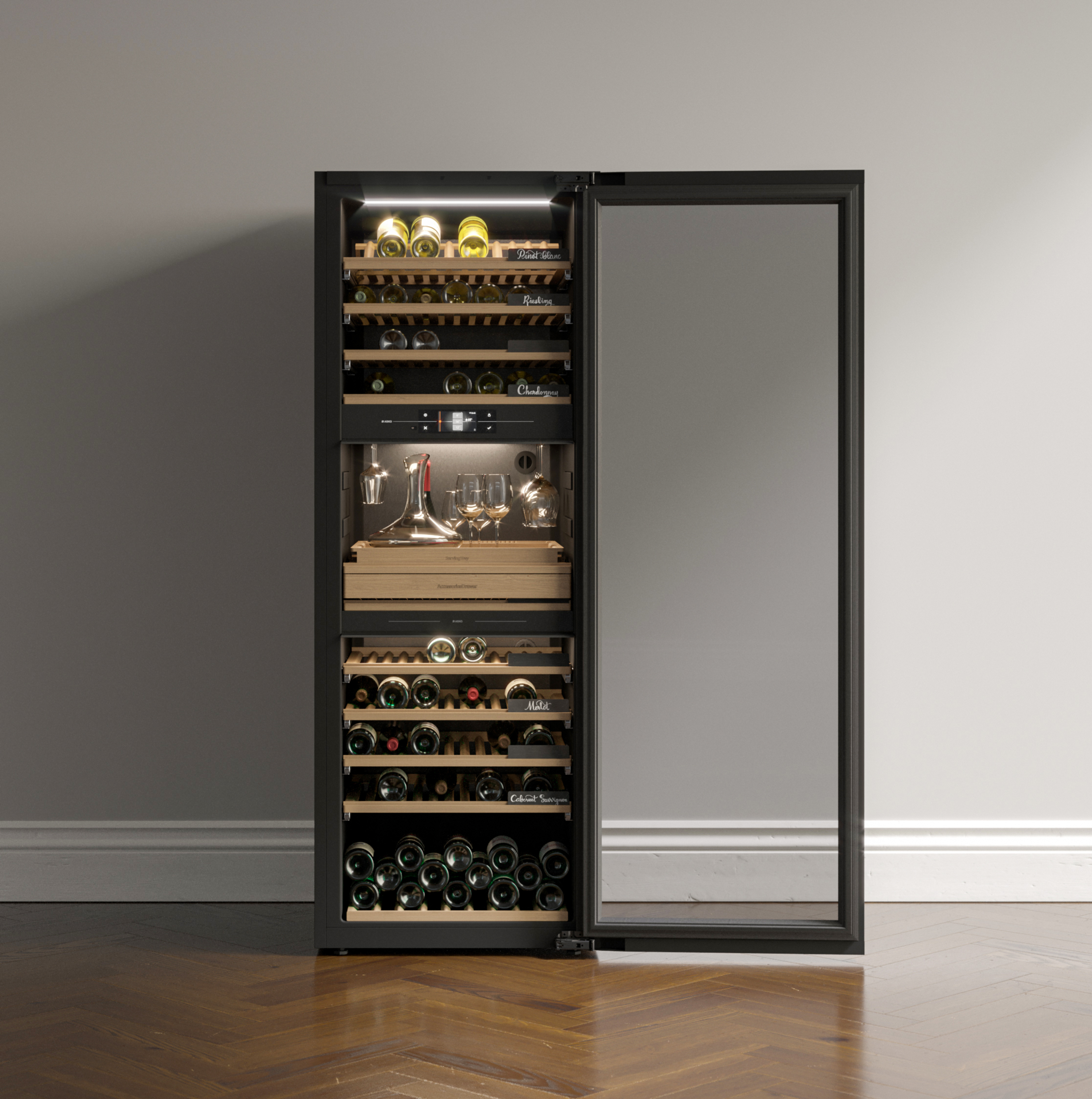
Guides
How noisy is a wine fridge?
Sound, noise and acoustics on the fridge
Wine refrigerators are not silent. The sound level can be a major source of irritation for some of us. Fortunately, we can do a lot ourselves to reduce the noise.
Wine refrigerators make a bit of noise. So do regular refrigerators. Maybe we just don't notice it that much. Here in the article you can read about noise from wine refrigerators and what acoustics in our homes do.
If we understand the causes of the noise and listen to some good advice from experienced professionals, we can significantly reduce the nuisance. However, there is great variation in the noise level of wine refrigerators.

The sound of your wine fridge
Most wine refrigerators have a noise level of around 35-45 decibels (dB). For comparison, a dishwasher in use is around 45-50 dB and an ordinary modern refrigerator is approx. 35 dB.
Generally speaking, a wine refrigerator thus emits slightly more noise than a normal refrigerator. This is due to a greater need for a constant temperature. The vast majority of wine refrigerators on the market consist of a compressor, a refrigerant circuit and a system of fans.
Some wine refrigerators can be low-energy or low-noise. These features are clear advantages, but all will have moving parts in them. These moving parts make it difficult to talk about a decidedly quiet wine fridge. Here we review the three main causes of noise from a wine refrigerator.
Blow on
Electric fans are used to maintain a stable and uniform temperature in parts of or the entire cabinet. Fans also help prevent the formation of hoarfrost in the cabinet. They consist of moving parts and will naturally emit noise. The hissing sound is reminiscent of the fan of a table fan.
The more fans in a cabinet, the more noise. Wine cabinets are most widely used in two versions: single temperature zone and with two temperature zones. With two zones, more fans are required, as air must be distributed in the cabinet's two chambers.
Depending on the ambient temperature and how often the door is opened, the fans run most of the time. The insulation ability of the door also plays a not insignificant role here, as the sound from the fans mainly comes from the inside of the cabinet.

Press and refrigerate
The compressor makes the cold, and it is usually located at the bottom at the back of the cabinet. It is preferably mounted on a silicone or rubber mount to reduce vibrations. The compressor's deep humming sound is unmistakable.
The compressor can make unnecessary noise if the cabinet is not level or if it hits something on the back of the cabinet. These sources of noise are the easiest to eliminate to begin with.
Fortunately, it is not constantly that the compressor is working, and often it is only when the compressor stops that we actually notice that it has been running at all. However, the low-frequency noise can be perceived differently by many people.
The third major cause of noise in a wine fridge is the refrigerant's journey around the system. The cold gas must be sent around the system when the thermostat gives notice of this. The coolant is then sent through a fine nozzle-like injection hole, resulting in a characteristic hissing sound.
Some would use a diplomatic expression to say that the sound is downright annoying. Again, we as humans can be more or less sensitive to certain sounds and frequency ranges.
On a brand new wine fridge, the injection hole is quite narrow. It just needs to be "driven a little more" during the first few months after purchase. During the break-in period, you will find that the sound is a little louder than expected. It will wear off with time.

What can I do about it?
As we can see, there are limited options to change the cabinet's functions if you are sensitive to the sound of a wine fridge. Most models are noisy, so there are not necessarily many benefits to be gained by choosing a wine cabinet from another manufacturer. It is difficult, if not impossible, to make a completely silent wine refrigerator.
On the other hand, there are many benefits to be gained by considering the environment in which the wine refrigerator is placed. If you take a wine refrigerator with a low sound level and place it in an environment that is acoustically unfavorable, it will probably not be experienced as a quiet wine fridge.
How noisy a wine refrigerator is therefore not necessarily the central question. It can be at least as interesting to ask how to make the experience of a wine fridge quiet. Our interior can help a lot with the feeling of having a wine fridge with a low noise level.

Klunk or cathedral
There is no clear definition of what is noise and what is not. What is a pleasant sound for one person can be extremely noisy and disturbing for another. However, the acoustics in a room are of decisive importance for the sound experience.
Acoustically, the old-fashioned clunk houses are fantastic at absorbing sound. The characteristic thick carpets on the floors, portière curtains, upholstered furniture and paintings on the walls are elements that are good at absorbing and dampening the sound in a room. The Klunkehmeit from the last two decades of the 19th century can teach us many useful things about acoustics, without us having to arrange ourselves as Mrs. Fernando Møhge would do. Any wine fridge would be perceived as quiet in such a home.
Nowadays, we arrange ourselves almost diametrically opposite. We prefer large surfaces, clean lines, hard materials and a limited use of textiles in the rooms. In addition to being today's modern and minimalist expression, this form of decoration is also practical and easy to clean. But we also build small cathedrals. Especially in the kitchen common room, where we can find ourselves exposing the ceiling to tilt, the sound can wander so freely that it brings memories of a large church room. In such an environment, it is a good idea to look at how much noise a wine refrigerator makes. But the room itself can therefore be the cause of the experience of noise from an otherwise quiet wine fridge.

Acoustic conditions
If you are a new builder, it can be a particularly good idea to include sound and acoustics in your considerations from the very first step. There is a sea of building materials that do not have to tear the bottom out of your budget. Your hardware store or contractor can certainly help here.
For the rest of us, there are also a few good tips and tricks. The clap test is good for quickly forming a picture of how the acoustics behave in a room. Clap loudly in the room and notice how much reverberation there is by listening to the echo. It doesn't take more than a second before it is experienced as bothersome.
Finally, there is good advice in relation to how you arrange your wine fridge. Some of the advice is general considerations, while others are addressed to the specific situation.
How noisy is a wine fridge in a kitchen?
We are often asked how noisy a wine fridge is. The answer is quite subjective and it depends on where it is placed.
Around 85 percent of our sold wine refrigerators are placed in a kitchen family room, and often in some form of combination with the rest of the kitchen's elements.
Sometimes the desire is to have a built-in wine fridge in a kitchen, other times an integrable wine fridge is the goal. In the latter case, the kitchen elements can help to dampen the noise significantly.
There is a difference between integrable and built-in in connection with wine refrigerators. An integrated wine fridge can typically be integrated into your kitchen cabinets, where a built-in wine fridge fits the width of a kitchen module and can therefore replace a section in the kitchen - for example under the worktop.
"First of all, the cupboard must be level and preferably not on a tiled floor.''
Technician Lars

Substrate and air circulation
Regardless of how you install your wine fridge, Lars has three general acoustic advice.
"First of all, the cabinet must be level and preferably not on a tiled floor. Next, I recommend that the cabinet stands on a sound-absorbing material such as a rubber mat or a thick carpet. And then you have to make sure that there is air around the cabinet, especially at the back. The harder it is for the heat to get away, the more the cabinet has to work to cool," says Lars, while explaining that the same advice applies to freestanding cabinets.
The remaining 15 percent of Lars' wine refrigerator customers place the cabinet in remote rooms such as a utility room, a shed or a basement. He says that with such a location, poor acoustics and noise are naturally not such a big problem.
The wine fridge must be level
The biggest source of noise and excessive energy consumption is if the wine fridge is not level.
It is not enough that the wine cabinet stands straight when you look at it. Precision is key here. Make sure you have a spirit level of some size and preferably a minimum of 60cm. long.
If your wine fridge is not completely level, you risk that the compressor makes more noise than necessary and that it runs more often than necessary, as the liquid level in the compressor seems to be out of balance. This causes, in addition to noise nuisance, an unnecessarily high energy consumption with great wear and tear on the compressor as a consequence.

From bad to good acousticss
So, if you take a few factors into consideration when buying a wine fridge, it is easy to get rid of noise nuisance. Either way, we hope you've got the answer to the question of how noisy a wine fridge is.
Sources of poor acoustics:
– Large rooms with high ceilings.
– Minimalist decor.
– Large window sections.
– Hard surfaces: tiles, tiles, glass and stone, but also bare plastered walls.
– Furniture in, for example, plastic.
Sources for better acoustics:
– Carpets, thick curtains and other thick textiles absorb sound.
– Furniture, paintings and trinkets can dampen reverberation.
– Use sound-absorbing batts when building, especially in high rooms.
For your wine fridge:
- Make sure the wine cabinet is completely level.
– Place it on a vibration- and noise-absorbing material.
– Provide air around the cabinet.